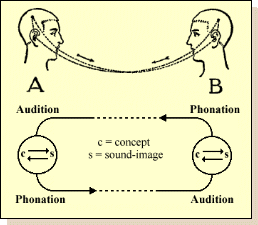We speak to be heard and need to be heard in order to be understood
~Roman Jakobson
Everyday references to communication are based on a ‘transmission’ model in which a sender transmits a message to a receiver – a formula that reduces meaning to explicit ‘content’ that resides within the text and is then delivered like a package.[1]This model allows for the conveyance of information through the exchange of thoughts, messages, or information by way of speech, signals, writing, or forms of behavior. For the purpose of this chapter, we will focus solely on verbal communication. It is through this focus on verbal communication that one can understand the benefits of good communication. Good communication allows for the reduction of conflict, greater confidence and therein greater persuasiveness in the speaker, the building of stronger relationships, and allows one to discover new ideas.
Below, one can see Saussure’s model of oral communication. This linear transmission model exemplifies how the speaker’s role is ‘active’ and the listener’s role is ‘passive’ (Chandler, p.179). His model was based on the notion that comprehension on the part of the listener mirrors the speaker’s initial process of expressing a thought (Chandler, p.180).
In 1960, Roman Jakobson proposed another model of verbal communication, an interpersonal verbal communication model which moved beyond the basic transmission model of communication. He outlines what he considers the six ‘constitutive factors…in any act of verbal communication’:
The addresser sends a message to the addressee. To be operative the message requires a context referred to (‘referent’ in another, somewhat ambivalent, nomenclature), seizable by the addressee, and either verbal or capable of being verbalized, a code fully, or at least partially, common to the addresser and addressee (or in other words, to the encoder and decoder of the message); and finally, a contact, a physical channel and psychological connection between the addresser and the addressee, enabling both of them to stay in communication.
(Jakobson 1960, 353)
Jakobson established the principle that one cannot make sense of signs without relating them to relevant codes (Chandler, p.181).
Saussure’s model excludes reference to the social world. Jakobson’s model, on the other hand, acknowledges the importance of the context involved in speech events (Chandler, p.182). He recognized the importance of both ‘the place occupied by the given messages within the context of surrounding messages…and…the relation of the given message to the universe of discourse.’[2]
Now that we understand the processes of encoding and decoding and contexts are central features when it comes to the determination of meanings, one can get a better understanding of how to effectively communicate a thought or idea. In order to be successful, effective communication skills are important. They are important both in the work force and in day-to-day life.
First, good communication skills help in reducing conflict. This can be between a parent a child, boss and co-worker, or even a teacher and student. What is important to recognize is that this conflict typically comes from misunderstanding. Teachers often run into this problem when trying to communicate with young children. Shy students or young preschoolers in particular often struggle to communicate because of speech problems or other impairments. Teachers should spend time talking with each student individually for a few minutes each day. Simple conversations about the child’s pets or siblings can help the student to feel more comfortable and help him/her to develop a dialogue. It is also important for teachers to talk to students as a class when explaining projects, and a good idea to encourage students to raise their hands if they have any questions. In order for children to understand how to converse, they must practice two-way conversation. Then, it is also a good idea to have the child repeat the assigned task. This will ensure that the child has heard the teacher and that there is no confusion. When one becomes an effective communicator, one can resolve conflict and create harmony by bridging the communication gap.
Good communication also allows for an increase in confidence in the speaker, which in turn allows for the speaker to develop greater persuasiveness. When one communicates effectively in ways people instinctively understand, people are more likely to help and provide one with necessary resources. Communicating effectively not only includes audible and understandable verbal language, but it includes good posture and polish. Standing up straight when speaking and maintaining good eye contact with one’s audience, are crucial public speaking elements. In terms of polish, there are various factors that come into play. A talented speaker has a way with words, and knows how to engage his audience. For example, humor and anecdotes are creative qualities that will cause the speaker to stick out in the listeners’ minds.
Effective communication also allows for the building of stronger relationships, both in business and one’s personal life. One learns and understands exactly what people want and how one can give it to them; people begin to instinctively understand one another.
Lastly, good communication skills allows for the discovery of what people want and need. Once one knows what people want and need, one can then work towards helping to match these needs. Specifically in the business world, this allows for greater cooperative efforts.

